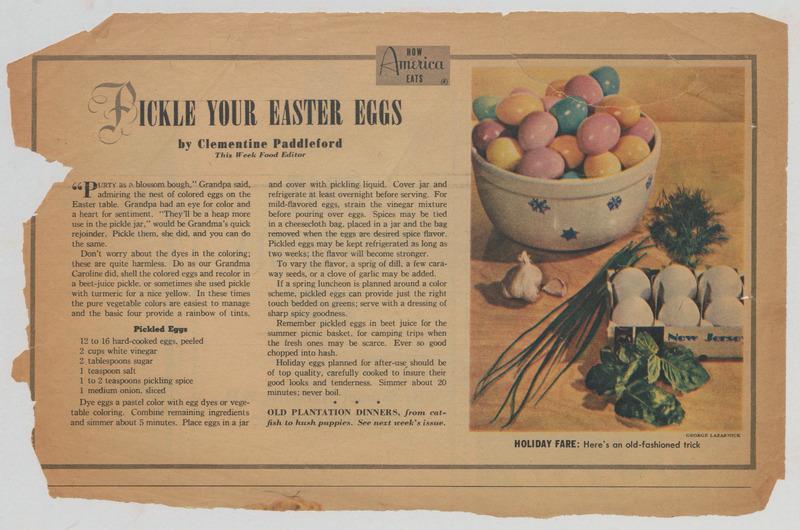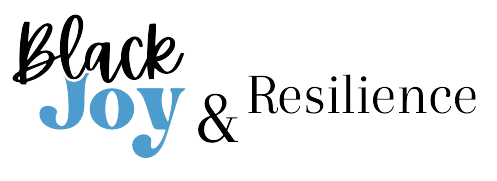"Pickle Your Easter Eggs"
Item
-
Title
-
"Pickle Your Easter Eggs"
-
Description
-
The front and back of a clipping pasted in a scrapbook from the Mother Bethel African Methodist Episcopal (AME) Church. The clipping contains a recipe for pickling dyed Easter eggs written by culinary journalist Clementine Paddleford. The back contains various advertisements.
-
Mother Bethel AME is one of the oldest Black Churches in the United States and the originator of the AME denomination, which the church’s founder, Bishop Richard Allen had incorporated in 1816. Its congregation held its first official service on July 29, 1794. The property on which the church rests was purchased in 1787 and is the oldest parcel of property continuously owned by African Americans in the US (Mother Bethel AME 2025).
Scrapbooking, whether practiced as a hobby or an intentional form of cultural reclamation and narrative making, serves as a form of resistance, collective joy making, and memory keeping.
The scrapbooker(s) most likely took the clipping from “This Week,” which was the “New York Herald Tribune’s nationally distributed Sunday Supplement (Levitt 2023).
-
Contributor
-
Mother Bethel African Methodist Episcopal Church
-
Date Created
-
c. 1950s
-
Rights
-
This work is not in copyright, but commercial uses of this digital representation are limited. For more information, contact Mother Bethel AME Church and see http://rightsstatements.org/page/NoC-NC/1.0/
-
Identifier
-
XVI. Scrapbook
-
Language
-
eng
-
Format
-
Text
-
Extent
-
1 page
-
Spatial Coverage
-
Philadelphia, PA
-
Subject
-
African American churches
-
Easter eggs
-
Formulas, recipes, etc.
-
Mother Bethel African Methodist Episcopal Church (Philadelphia, Pa.)
-
Paddleford, Clementine, 1898-1967
-
Pickled foods
-
Scrapbooks
-
transcription
-
How America Eats
Pickle Your Easter Eggs
by Clementine Paddleford
This Week Food Editor
“Purity as a blossom bough,” Grandpa said, admiring the nest of colored eggs on the Easter table. Grandpa had an eye for color and a heart for sentiment. “They’ll be a heap more use in the pickle jar,” would be Grandma’s quick rejoinder. Pickle them, she did, and you can do the same.
Don’t worry about the dyes in the coloring; these are quite harmless. Do as our Grandma Caroline did, shell the colored eggs and recolor in a beet-juice pickle, or sometimes she used pickle with turmeric for a nice yellow. In these times the pure vegetable colors are easiest to manage and the basic four provide a rainbow of tints.
Pickled Eggs (bolded font)
12 to 16 hard-cooked eggs, peeled
2 cups white vinegar
2 tablespoons sugar
1 teaspoon salt
1 to 2 teaspoons pickling spice
1 medium onion, sliced
Dyed eggs a pastel color with egg dyes or vegetable coloring. Combine remaining ingredients and simmer about 5 minutes. Place eggs in a jar and cover with pickling liquid. Cover jar and refrigerate at least overnight before serving. For mild-flavored eggs, strain the vinegar mixture before pouring over eggs. Spices may be tied in a cheesecloth bag, placed in a jar and the bag removed when the eggs are desired spice flavor. Pickled eggs may be kept refrigerated as long as two weeks; the flavor will become stronger.
To vary the flavor, a sprig of dill, a few caraway seeds, or a clove of garlic may be added.
If a spring luncheon is planned around a color scheme, pickled eggs can provide just the right touch bedded on greens; serve with a dressing of sharp spicy goodness.
Remember pickled eggs in beet juice for the summer picnic basket, for camping trips when the fresh ones may be scarce. Ever so good chopped into hash.
Holiday eggs planned for after-use should be of top quality, carefully cooked to insure their good looks and tenderness. Simmer about 20 minutes; never boil.
OLD PLANTATION DINNERS, from cat-fish to hush puppies. See next week’s issue.
(Photo credit) George Lazarnick
(Photo caption) HOLIDAY FARE: Here’s an old-fashioned trick

 Recipe for pickled eggs
Recipe for pickled eggs